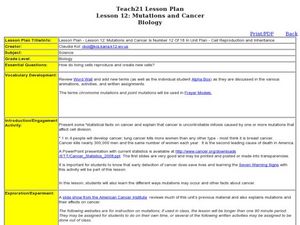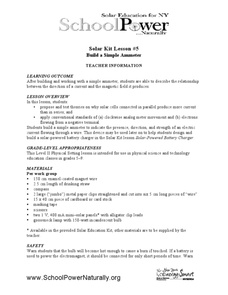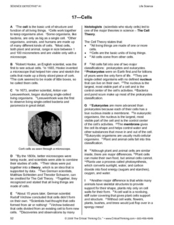Curated OER
Solar Car Series: during What Part of the Day Can the Most Sun Power Be Collected?
In preparation for solar car races, middle schoolers attempt to discover what time of day the most solar energy can be collected. Begin by demonstrating the use of a voltmeter for measuring solar cell output. Take them outdoors to take...
Teach Engineering
Cellular Respiration and Bioremediation
You can breathe easily now that you've found a winning resource. Young biologists learn about the process of cellular respiration, primarily through teacher-led discussion and instruction. They also consider the concept of...
Curated OER
Genetic Disorders
Students examine how living cells create new cells and how genetic mutations can cause disorders and be inherited. In this genetic reproductionn lesson students create their own PowerPoint presentation.
Curated OER
Sounding Smart!
A list of vocabulary terms relating to the cell membrane tops this page. Biology learners show what they know by using the words to write a paragraph about cell membrane structure and function. Consider using this as a quiz or part of a...
Curated OER
AP: Chapter 8: Membranes
AP biology buffs dismantle the mystery of the cell membrane by explaining its structure and function. They decipher membrane fluidity, define the roles of membrane proteins, and analyze a diagram of a selectively permeable membrane...
Curated OER
Blood
Although there are vocabulary terms in this PowerPoint that use British spelling, the presentation is attractive and educational. The content flows from the general composition of blood, into the different types of blood cells and their...
Curated OER
Mutations and Cancer
Students study how cancer cells mutate and affect cell division. In this investigative lesson students view a PowerPoint presentation learn the seven warning signs of cancer.
Curated OER
Genetic Disorders
Students examine how living cells reproduce and how traits are passed on. In this genetic reproduction lesson students research a topic and present it to the class.
K20 LEARN
What's My Purpose In This Life? Intro To Cell Theory/Organelles
Why are we here? Well, if you happen to be a Golgi body, the answer is simple! Young biologists embark upon a journey through the tiny world of cellular organelles with an engaging lesson from the K20 Center. The activities open with an...
Curated OER
Technology and Teen Abuse
Students research dating abuse, particularly as it affects teens in general and specifically when technology like cells phones and the Internet is involved. They develop and use a survey on dating abuse in thier school and use the...
Curated OER
Solar Kit Lesson #5 - Build a Simple Ammeter
Emerging electricians build a simple ammeter for making measurements on an electric current. They test the placement of solar cells in both series and parallel circuits and examine the magnetic field produced by the movement of electrons...
Curated OER
Mutations
After studying DNA replication and the genetics of inheritance, this slide show is useful for explaining specific mutations that can happen and result in an illness. Sickle cell anemia, and cystic fibrosis are explained on a genetic...
Curated OER
Driving Safety and Distractions
Students research process necessary to add local or state law limiting such driving distractions as cell phones or other technological devices, interview city leaders or legislators, research areas that already have such legislation and...
Curated OER
Cells Group Creative Writing
Tap into writing skills in your science class with this creative writing activity! Get your class to learn the words mitochondria, cytoplasm, chloroplast, chlorophyll, nucleolus, nucleus, tissues, organs, vacuole, and chromosome by...
Curated OER
Mobile Phones
Why do we use phones? How does our language change on the phone? Learners practice phone conversations with the dialogues provided. They practice written phone dialogues with a partner, and create and perform phone conversations to...
Curated OER
Mitosis and the Cell Cycle
Uncomplicated and useful, this PowerPoint introduces viewers to the five stages of mitosis. For each stage, there is a slide that lists the main occurrences. Show this as a note-taking guide when you lecture on mitosis to keep your young...
Curated OER
Study Guide for Chapter 12: The Cell Cycle
In this biology worksheet students map out and describe the process of mitosis for the nine questions. The last four questions are several combined in each.
Curated OER
Cell Phones with Cameras Banned in Locker Rooms
Young scholars research the way phones work and what places - both locally and nationally - have already faced the problem of in appropriate use. Students also interview gym owners or managers in their community and those who use they...
Curated OER
Cell 3: Organelles B
Students, after researching cells, construct a model cell. They explain the structure and function of eukaryotic organelles in a presentation. In addition, they create their own analogies to describe the structure and function of...
Curated OER
Structure and Function of the Cell/Introduction to the Cell
So, this is not technically a worksheet, but rather a chapter of reading material, pictures, and diagrams introducing young biologists to the cell. Cell theory, diversity, size, and shape are described. The internal organization and...
Curated OER
17 - Cells
The first of three pages in this handout provides a brief history of our understanding of the cell. It also differentiates between prokaryotic and eukaryotic cells. The second is a collection of true and false, multiple choice, and short...
Curated OER
Stem Cell Development
Like a fresh canvas, stem cells can turn into almost anything. In a comprehensive lesson, high school biologists use clay to build a 3-D model of cell division and the processes that occur during the first 14 days of development. Also...
Curated OER
Extracting DNA from Your Cells
Three steps are needed to extract DNA from learners' inner cheek cells. The procedure and reasons for each step are explained. As enzymes work on the cells, a series of questions are answered regarding the structure of the DNA molecule....
Cornell University
The Galvanic Cell Game
Play a little game with your classes! Young scholars expand on their understanding of oxidation/reduction reactions in a game-based activity. They build a Galvanic cell with game pieces while learning about each component and their...
Other popular searches
- Animal Cells
- Plant and Animal Cells
- Plant Cells
- Stem Cells
- Eukaryotic Cells
- Blood Cells
- Cells Crossword
- Cells and Organelles
- Cheek Cells
- Life Science on Cells
- Microscope Cheek Cells
- 3d Animal Cell

























